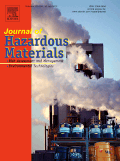
JOURNAL OF HAZARDOUS MATERIALS
metrics 2024
Unraveling the Complexities of Pollution and Toxicity
Introduction
JOURNAL OF HAZARDOUS MATERIALS, published by Elsevier, stands as a leading academic platform in the fields of Environmental Chemistry, Environmental Engineering, and Pollution Studies. With a solid impact captured through its Q1 ranking across multiple relevant categories, this journal is essential for researchers focusing on the management and mitigation of hazardous materials. Originating in 1975 and continuing to present insight until 2024, it provides valuable peer-reviewed content that informs best practices within health, toxicology, mutagenesis, and waste management. Furthermore, its impressive Scopus rankings highlight its influence, securing a position in the top percentile among global publications. While access to the journal is not open access, its rigorous approach to impactful research makes it indispensable for academics, industry professionals, and students seeking to deepen their understanding and innovate in this critical area of study.
Metrics 2024
 2.95
2.95 12.20
12.20 11.90
11.90 352
352Metrics History
Rank 2024
Scopus
IF (Web Of Science)
JCI (Web Of Science)
Quartile History
Similar Journals

Environmental Chemistry Letters
Empowering the next generation of environmental scientists.Environmental Chemistry Letters, published by Springer Heidelberg, stands at the forefront of interdisciplinary research within the field of Environmental Chemistry. Since its inception in 2003, this esteemed journal has provided a dynamic platform for the dissemination of innovative studies and groundbreaking findings, contributing significantly to the understanding of chemical processes affecting the environment. With an impressive impact factor and ranking third out of 147 journals in Environmental Chemistry (98th percentile as per Scopus), it consistently attracts high-quality submissions from researchers around the globe. The journal maintains a Q1 category rank as of 2023, underscoring its prominent position in scholarly discourse. Environmental Chemistry Letters is dedicated to advancing knowledge on contemporary environmental issues, fostering solutions to mitigate chemical pollution, and promoting sustainable practices across various sectors. Researchers, professionals, and students alike will find invaluable resources within its pages as it continues to illuminate the path toward environmental sustainability.

Journal of Hazardous Materials Advances
Championing accessibility in hazardous materials scholarship.The Journal of Hazardous Materials Advances, published by ELSEVIER, is a premier open-access journal dedicated to advancing the understanding and management of hazardous materials. Established in 2021, this journal has quickly gained recognition, securing a place in the prestigious Q1 quartile across multiple categories, including Environmental Chemistry, Environmental Engineering, Health, Toxicology and Mutagenesis, Pollution, and Waste Management and Disposal. With its impactful research indexed under ISSN 2772-4166, the journal not only prioritizes quality but also promotes accessibility to its scholarly outputs, ensuring that vital findings are readily available to the global research community. As part of Scopus, the Journal ranks competitively in various subfields of Environmental Science, reflecting its vital role in addressing contemporary environmental challenges. Researchers, professionals, and students can rely on this journal to provide innovative insights and solutions in the ever-evolving landscape of hazardous material management and its implications for public health and environmental sustainability.
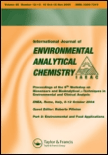
INTERNATIONAL JOURNAL OF ENVIRONMENTAL ANALYTICAL CHEMISTRY
Pioneering research for a sustainable future.INTERNATIONAL JOURNAL OF ENVIRONMENTAL ANALYTICAL CHEMISTRY, published by Taylor & Francis Ltd, stands as an essential resource in the interdisciplinary field of environmental science and analytical chemistry. With a history dating back to 1971 and a convergence period extending to 2024, this journal addresses urgent global challenges by providing a platform for high-quality research that encompasses pivotal aspects of environmental analysis, pollution, and public health. The journal’s significant impact is reflected in its 2023 rankings, placing it in the second and third quartiles across various relevant categories, including Analytical Chemistry, Environmental Chemistry, and Water Science and Technology. Researchers and practitioners are encouraged to contribute to its wealth of knowledge, making it a vital reference for emerging studies in Health, Toxicology and Mutagenesis and beyond. Although it is not an open-access journal, subscriptions provide unparalleled access to groundbreaking research that can influence both academia and industry practices.
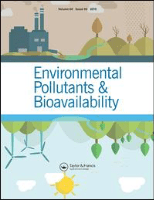
Environmental Pollutants and Bioavailability
Advancing Research on Pollutants and BioavailabilityEnvironmental Pollutants and Bioavailability, published by Taylor & Francis Ltd, serves as a critical platform for disseminating high-quality research focused on the interactions between environmental contaminants and biological systems. Since its inception as an Open Access journal in 2019, it has rapidly gained recognition within the scientific community, achieving a commendable Q2 ranking in multiple categories including Chemical Health and Safety, Health, Toxicology and Mutagenesis, and Toxicology for the year 2023. The journal aims to bridge the gap between environmental science and public health by exploring innovative methodologies, risk assessments, and bioavailability studies related to pollutants. Located in the United Kingdom, Environmental Pollutants and Bioavailability is positioned to impact ongoing discourse and research practices in the fields of toxicology and environmental safety, making it an invaluable resource for researchers, professionals, and students dedicated to advancing knowledge in these critical areas.

Journal of Hazardous Materials Letters
Advancing knowledge on hazardous materials for a safer tomorrow.Journal of Hazardous Materials Letters, published by ELSEVIER, is a premier open access journal that has rapidly gained prominence in the fields of Environmental Chemistry, Environmental Engineering, Health, Toxicology and Mutagenesis, Pollution, and Waste Management and Disposal since its inception in 2020. With an impressive categorization in the top quartile (Q1) across all its relevant disciplines in 2023, this journal ranks favorably within the Scopus database, positioning itself in the upper echelons of Environmental Science—ranked 23rd in Environmental Engineering and 19th in Health, Toxicology and Mutagenesis among its peers. It serves as a vital platform for the dissemination of high-quality research focused on addressing hazardous materials and their impacts on health and the environment. The journal's commitment to open access facilitates immediate and broad dissemination of research findings, ensuring that essential knowledge reaches a global audience of researchers, professionals, and students eager to advance the field. With its ongoing convergence into 2024, the Journal of Hazardous Materials Letters continues to drive innovation and influence practice in managing hazardous materials for a sustainable future.

Environmental Chemistry and Ecotoxicology
Transforming environmental science through open access.Environmental Chemistry and Ecotoxicology, published by KEAI PUBLISHING LTD, is a pioneering Open Access journal that has been at the forefront of research since its establishment in 2019. With an impressive trajectory that converges research excellence until 2024, the journal focuses on critical developments in the fields of environmental chemistry and ecotoxicology. It boasts a commendable market position, ranking in the top 3% among leading journals in Agricultural and Biological Sciences, Environmental Science, and related disciplines, as demonstrated by its high Scopus ranks. The journal is committed to disseminating groundbreaking research that addresses the pressing challenges of environmental sustainability and chemical safety, making it an essential resource for researchers, professionals, and students aiming to navigate the complexities of our ecological landscapes. By embracing an Open Access model, the journal ensures that valuable insights are accessible to a global audience, fostering collaboration and innovation in the field.

Marine Pollution Bulletin
Exploring the depths of marine pollution research.Marine Pollution Bulletin is a premier interdisciplinary journal dedicated to publishing innovative research and critical reviews focused on the impact of human activities on marine ecosystems. Published by PERGAMON-ELSEVIER SCIENCE LTD, this journal is renowned for its rigorous peer-review process and holds a prestigious position in the academic community, with a 2023 Q1 ranking in Aquatic Science, Oceanography, and Pollution. With a history spanning from 1970 to 2024, it provides a vital platform for researchers, professionals, and students alike to share groundbreaking findings in marine environmental science. The journal, based in the United Kingdom at The Boulevard, Langford Lane, Kidlington, Oxford OX5 1GB, England, is indexed in Scopus and ranks impressively in various categories, underscoring its significance in advancing the understanding of marine pollutants and their ecological consequences. Submissions are encouraged for original research, review articles, and case studies that contribute to this critical field, enabling the academic community to explore solutions for mitigating marine pollution.

Journal of Xenobiotics
Shedding light on the effects of xenobiotics in our world.Journal of Xenobiotics, published by MDPI in Switzerland, is an esteemed open-access journal dedicated to advancing the understanding of xenobiotic substances and their impact on environmental health and biological systems. Since its inception in 2011, the journal has made significant strides in the field, earning a prestigious Q1 ranking across categories such as Pharmacology, Pollution, and Toxicology in 2023, showcasing its pivotal role in disseminating high-quality research. With its recent Scopus rankings reflecting a solid position in Environmental Science and Pharmacology disciplines, the journal serves as a vital platform for researchers, professionals, and students interested in the mechanisms and consequences of pollutants and toxic substances in various settings. The Journal of Xenobiotics continuously fosters open collaboration and knowledge exchange, allowing for inclusive dialogue on contemporary issues, making its articles readily accessible for the global scientific community.
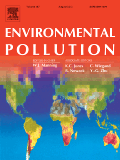
ENVIRONMENTAL POLLUTION
Unveiling the science behind environmental contaminants.Environmental Pollution, published by Elsevier Science Ltd, stands at the forefront of research related to environmental contaminants and their effects on health and ecosystems. With an impressive impact factor reflected in its Q1 rankings across various categories including Health, Toxicology, and Pollution, this journal is a pivotal resource for academics and professionals in the fields of environmental science and toxicology. The journal, established in 1973, continues to disseminate high-quality articles that explore the implications of pollution and advance knowledge on toxicological impacts and mitigation strategies. Although it is not an open-access journal, it offers robust visibility within the scientific community, ensuring vital research reaches those who need it most. Researchers, students, and professionals dedicated to understanding and addressing the challenges of environmental pollution will find Environmental Pollution to be an indispensable platform for their work, guiding the ongoing dialogue on sustainable practices and public health protection.
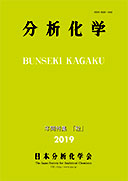
BUNSEKI KAGAKU
Empowering the Next Generation of ChemistsBUNSEKI KAGAKU, published by the Japan Society Analytical Chemistry, is a reputable journal dedicated to the field of analytical chemistry. With an ISSN of 0525-1931, this journal has been a crucial outlet for scholarly communication since its inception in 1952, converging its publication years from 1954 to 1957 and from 1959 to 2024. Although it holds a Q4 category ranking in the most recent 2023 quartiles of analytical chemistry and ranks 153/156 in Scopus, it continues to serve as a platform for quality research, fostering advancements in the field. BUNSEKI KAGAKU is based in Tokyo, Japan, and emphasizes the critical importance of analytical techniques in scientific inquiry. With a commitment to professionalism and rigor, the journal provides a vital resource for researchers, students, and professionals seeking to explore innovative methodologies and contribute to the ongoing dialogue in analytical chemistry.